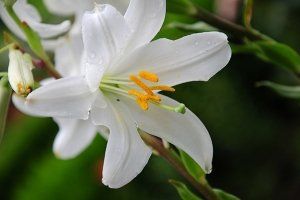
808-989-6149
OPEN
Monday-Friday 8:30am - 5pm
(Closed 12-1p for Lunch)
Saturday / Sunday Emergency Only
Address: 66-1520 Puu Huluhulu Rd
Kamuela, HI 96743
Email: info@ainahouanimalhospital.com
Toxic and Non-Toxic Plants
Call Anytime, 24/7 For Emergency Care

If there is any possibility your pet ate a Toxic Plant,
get medical attention
IMMEDIATELY!!!
(808) 989-6149


Toxic and Non-Toxic Plants
This list contains plants that have been reported as having an effect on animals and/or intense effects on the gastrointestinal tract.
NOTE: Please note that the information contained in our plant lists is not meant to be all-inclusive, but rather a compilation of the most frequently encountered plants.
If you think that your animal is ill or may have ingested a poisonous substance,
Contact US immediately, 24/7 at (808) 989-6149
or the National 24-hour emergency poison hotline directly at 1-888-426-4435 (fee charged for service).
Toxic and Non-Toxic Plants
Lilies
Members of the Lilium spp. are considered to be highly toxic to cats. While the poisonous component has not yet been identified, it is clear that with even ingestion of very small amounts of the plant, severe kidney damage could result.Marijuana
Ingestion of Cannabis sativa by companion animals can result in depression of the central nervous system and in-coordination, as well as vomiting, diarrhea, drooling, increased heart rate, and even seizures and coma.Sago Palm
All parts of Cycas Revoluta are poisonous, but the seeds or "nuts" contain the largest amount of toxin. The ingestion of just one or two seeds can result in very serious effects, which include vomiting, diarrhea, depression, seizures and liver failure.Tulip/Narcissus bulbs
The bulb portions of Tulipa/Narcissus spp. contain toxins that can cause intense gastrointestinal irritation, drooling, loss of appetite, depression of the central nervous system, convulsions and cardiac abnormalities.Azalea/Rhododendron
Members of the Rhododenron spp. contain substances known as grayantoxins, which can produce vomiting, drooling, diarrhea, weakness and depression of the central nervous system in animals. Severe azalea poisoning could ultimately lead to coma and death from cardiovascular collapse.Oleander
All parts of Nerium oleander are considered to be toxic, as they contain cardiac glycosides that have the potential to cause serious effects—including gastrointestinal tract irritation, abnormal heart function, hypothermia and even death.Castor Bean
The poisonous principle in Ricinus communis is ricin, a highly toxic protein that can produce severe abdominal pain, drooling, vomiting, diarrhea, excessive thirst, weakness and loss of appetite. Severe cases of poisoning can result in dehydration, muscle twitching, tremors, seizures, coma and death.Cyclamen
Cyclamen species contain cyclamen, but the highest concentration of this toxic component is typically located in the root portion of the plant. If consumed, Cyclamen can produce significant gastrointestinal irritation, including intense vomiting. Fatalities have also been reported in some cases.Kalanchoe
This plant contains components that can produce gastrointestinal irritation, as well as those that are toxic to the heart, and can seriously affect cardiac rhythm and rate.Yew
Taxus spp. contains a toxic component known as taxine, which causes central nervous system effects such as trembling, in-coordination, and difficulty breathing. It can also cause significant gastrointestinal irritation and cardiac failure, which can result in death.Amaryllis
Common garden plants popular around Easter, Amaryllis species contain toxins that can cause vomiting, depression, diarrhea, abdominal pain, hyper-salivation, anorexia and tremors.Autumn Crocus
Ingestion of Colchicum autumnale by pets can result in oral irritation, bloody vomiting, diarrhea, shock, multi-organ damage and bone marrow suppression.Chrysanthemum
These popular blooms are part of the Compositae family, which contain pyrethrins that may produce gastrointestinal upset, including drooling, vomiting and diarrhea, if eaten. In certain cases depression and loss of coordination may also develop if enough of any part of the plant is consumed.English Ivy
Also called branching ivy, glacier ivy, needlepoint ivy, sweetheart ivy and California ivy,Hedera helix contains triterpenoid saponins that, should pets ingest, can result in vomiting, abdominal pain, hyper-salivation and diarrhea.Peace Lily (AKA Mauna Loa Peace Lily)
Spathiphyllum contains calcium oxalate crystals that can cause oral irritation, excessive drooling, vomiting, difficulty in swallowing and intense burning and irritation of the mouth, lips and tongue in pets who ingest.
Pothos
Pothos (both Scindapsus and Epipremnum) belongs to the Araceae family. If chewed or ingested, this popular household plant can cause significant mechanical irritation and swelling of the oral tissues and other parts of the gastrointestinal tract.Schefflera
Schefflera and Brassaia actinophylla contain calcium oxalate crystals that can cause oral irritation, excessive drooling, vomiting, difficulty in swallowing and intense burning and irritation of the mouth, lips and tongue in pets who ingest.Related Links
Top Pet Toxins of 2012
In 2012, the ASPCA Animal Poison Control Center (APCC) in Urbana, Illinois, handled more than 180,000 cases
about pets exposed to possibly poisonous substances.
Top Pet Toxins of 2012
In 2012, the ASPCA Animal Poison Control Center (APCC) in Urbana, Illinois, handled more than 180,000 cases
about pets exposed to possibly poisonous substances.

